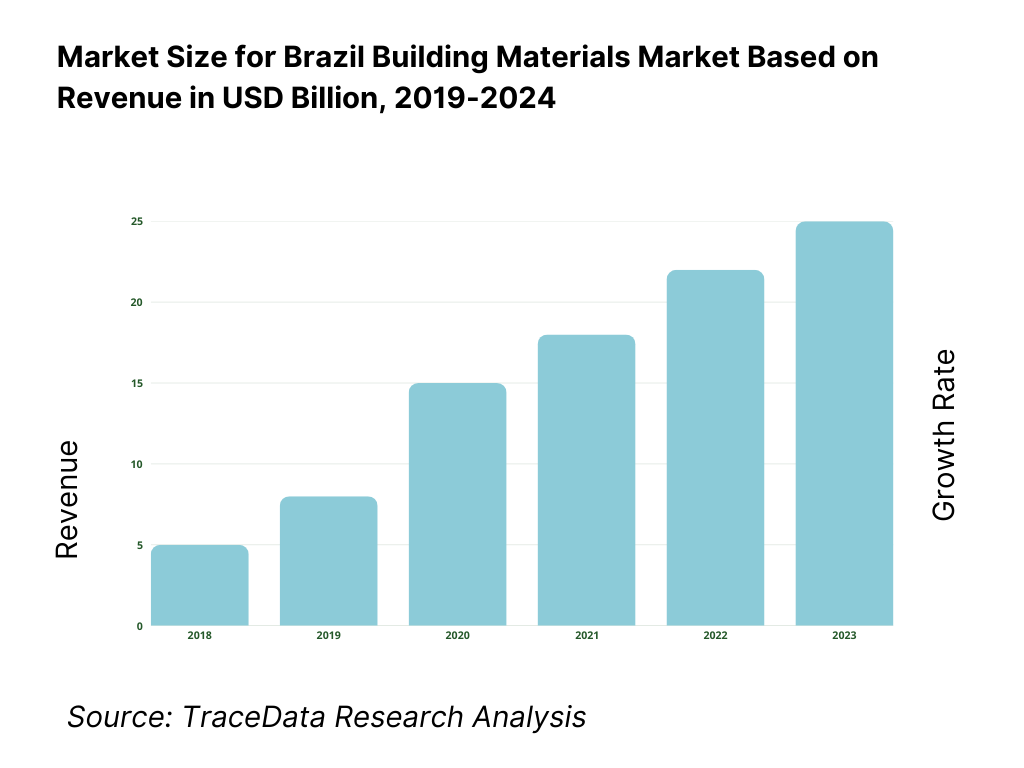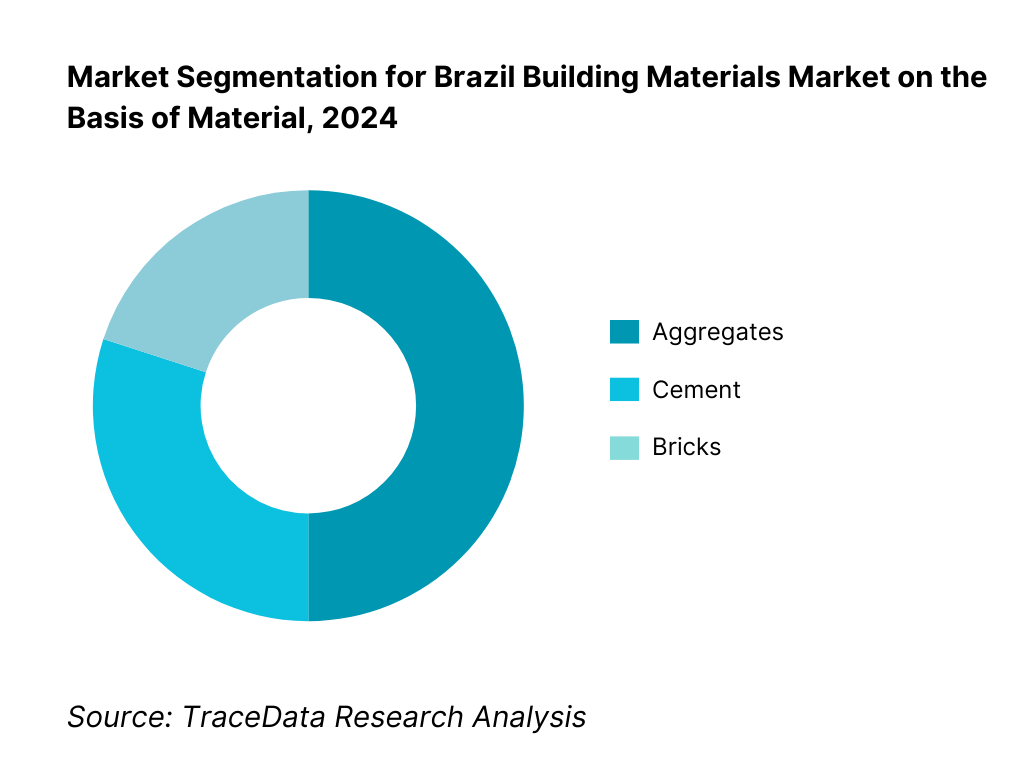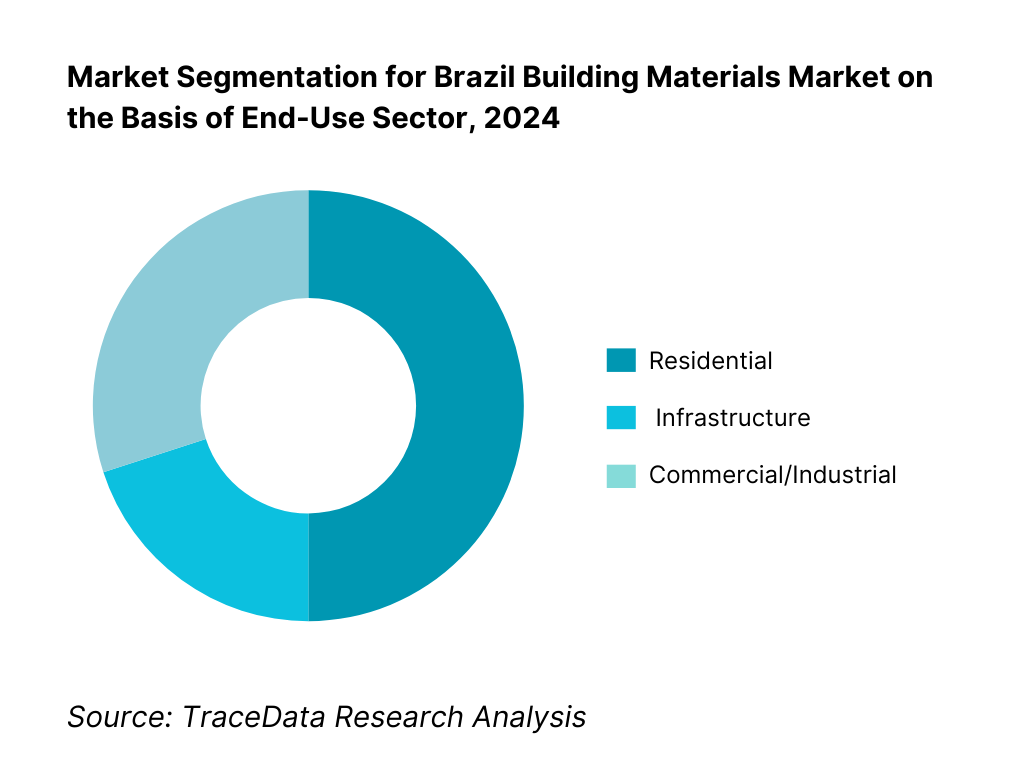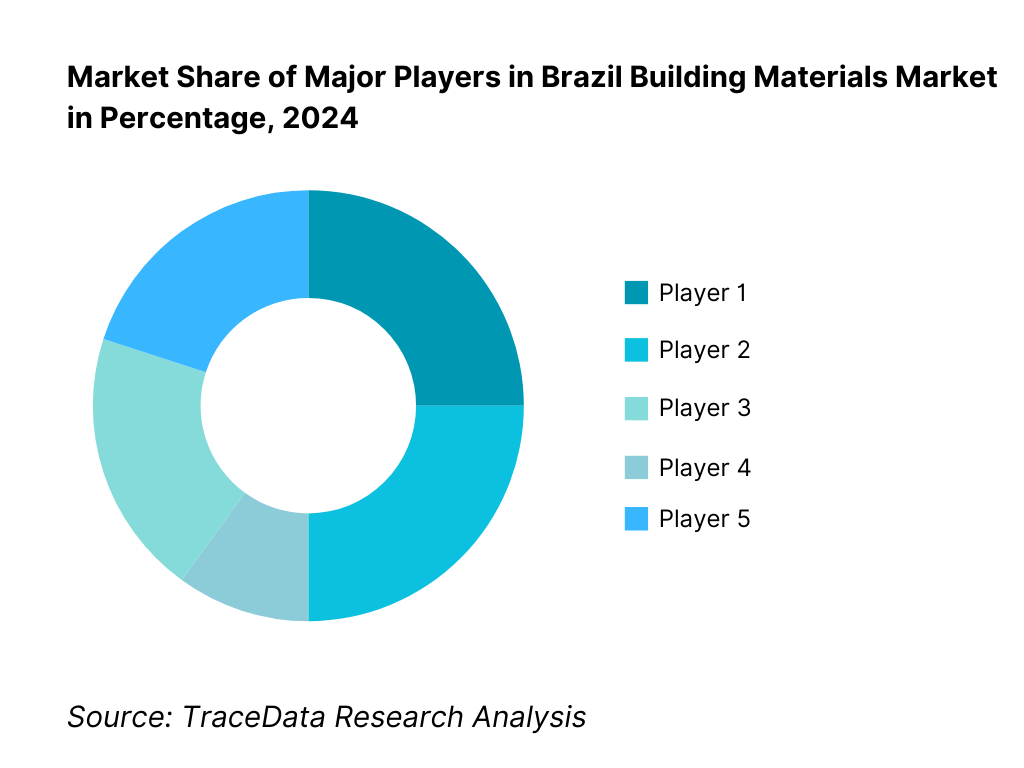Brazil Building Materials Market Outlook to 2030
By Material Type, By End-Use Sector, By Construction Stage, By Distribution Channel, By Sustainability Attribute, and By Region
- Product Code: TDR0239
- Region: Central and South America
- Published on: August 2025
- Total Pages: 110
Introducing the World's FirstPay-Per-Section Market Reports
Why pay for the full report when you need just a part?
Start Building Your Report
Scroll down to see available sections
Report Summary
The report titled “Brazil Building Materials Market Outlook to 2030 – By Material Type, By End-Use Sector, By Construction Stage, By Distribution Channel, By Sustainability Attribute, and By Region” provides a comprehensive analysis of Brazil’s construction inputs industry. The study covers the overview and genesis of the sector, overall market size in terms of revenue and volumes, and granular market segmentation. It details trends and developments, the regulatory and standards landscape, customer-level profiling, issues and challenges, and the competitive landscape including competition scenario, cross-comparison dashboards, opportunity pockets and bottlenecks, and company profiling of major players across cement, steel, chemicals, pipes, finishes, and tiles. The report concludes with future market projections based on material volumes, product/system mixes, regional pipelines, and cause-and-effect relationships, alongside success case studies and cautionary notes that highlight the key opportunities and risks for stakeholders.
Brazil Building Materials Market Overview and Size
The Brazil building materials market is valued at USD 15.8 billion, based on five-year historical data and recorded revenues. Its growth through to 2023 is underpinned by a broad economic expansion, with Brazil’s real GDP rising by 2.9 percent in 2023, fueling demand from both private and public construction activities.
Major metropolitan centers such as São Paulo and Rio de Janeiro dominate the market due to their dense urbanization and sustained infrastructure and residential development. Economic hubs attract both domestic and foreign investment into large-scale commercial, housing, and infrastructure projects, reinforcing their leadership in building materials consumption.

What Factors are Leading to the Growth of the Brazil Building Materials Market:
Housing pipeline & urban demand anchored by federal programs: Brazil’s public housing engine is putting real volumes into the construction funnel. The Ministry of Cities reports 1,260,000 Minha Casa, Minha Vida units contracted between the program relaunch and the end of the year, creating direct pull for cement, steel rebar, PVC piping, ceramic blocks and finishes across supply chains. This sits on top of a large, urbanizing market base—203,062,512 residents counted by the latest census—concentrated in metropolitan areas that continuously require new housing and refurbishment. The combination of a million-plus unit pipeline and a 203-million population sustains multi-year materials off-take, order visibility for distributors, and capacity utilization for upstream producers.
Macroeconomic scale and investment tailwinds: A larger macro base increases absolute spend on buildings and infrastructure, lifting demand for aggregates, concrete, steel, glass and engineered wood. IBGE confirms the economy closed the year at R$ 11.7 trillion in current prices, while the following quarter opened with R$ 3.0 trillion of output, providing working capital headroom for public and private builders and their material suppliers. Elevated formal employment also supports residential renovations and small-project demand. These top-line volumes improve creditworthiness for merchants and fund working inventories of high-turn SKUs (cement, ceramic tiles, paints) and long-lead items (structural steel).
Infrastructure and sanitation works underpin multi-year materials off-take: The federal Novo PAC program lists R$ 1.8 trillion in investments with sector eixos that intensively consume building materials; within logistics alone the government highlighted 151 port projects totaling R$ 54.9 billion, each requiring piles, cement, structural metals, coatings and MEP supplies. In sanitation—another structural demand driver—the official SNIS figures cited by a central-bank-linked development paper show 171,042,954 people served by water systems, evidencing the enormous installed base needing expansions and replacement parts such as pipes, valves and fittings. Together, the pipeline and the installed base move tonnage at scale through distributors into job sites.
Which Industry Challenges Have Impacted the Growth of the Brazil Building Materials Market:
Credit conditions and financing sensitivity of materials demand: Construction volumes in Brazil remain sensitive to funding costs for developers, contractors and households. The Central Bank’s monetary policy committee set the Selic target at 10.50 during its May decision and kept it at 10.50 in July, levels that weigh on construction credit and dealer working-capital lines. With an economy still producing R$ 3.0 trillion in the next quarter, the interest-rate channel remains the key headwind for inventory carry and conversion of project backlogs into purchases of heavy materials (cement, steel) and finished items (doors, glazing). Procurement cycles lengthen and order batching increases under higher benchmark rates.
Freight and logistics constraints across a continental network: Material flows face scale frictions across Brazil’s vast geography. The government’s National Logistics Plan reports 2,386.7 billion ton-kilometers of freight displacement, a magnitude that stresses road-centric corridors moving cement, steel and ceramics from plants to urban job sites. Railways remain important for bulk inbound: the Transport Ministry tallied a 540 million-ton rail volume, helpful for aggregates and steel coils but still requiring road legs into urban distribution. These absolute volumes translate into higher inventory requirements at merchants, more buffer stock at sites, and lead-time variability—particularly during weather-related disruptions that affect road surfaces and port gates.
Multi-layered environmental licensing and municipal permitting: Projects must navigate federal environmental licensing under CONAMA Resolution 237, plus state and municipal procedures across 5,570 municipalities, adding time and coordination costs to material procurement schedules. IBAMA reports issuing 498 federal licenses in one year and 548 the next, illustrating a heavy administrative load at the federal tier alone. For material suppliers and contractors, these layers shape when bulk orders for cement, structural steel, coatings and mechanical systems are released, often requiring staged deliveries and warehousing to match license milestones.
What are the Regulations and Initiatives which have Governed the Market:
Federal environmental licensing (CONAMA 237) and IBAMA execution: Environmental impact studies and installation/operation licenses under CONAMA 237 define the gating of large sites that absorb heavy materials. To illustrate throughput, IBAMA discloses 498 federal environmental licenses issued in one year and 548 in the next—each license unlocking packages of concrete, steel, aggregates, coatings and utilities equipment at specific construction phases. Suppliers should align delivery schedules to these federal milestones, then dovetail with state/municipal requirements for local works such as drainage and façade changes.
Housing procurement rules via Minha Casa, Minha Vida (MCMV): MCMV defines eligibility, financing channels and technical quality requirements for social housing, structuring demand for core materials. The government confirms 1,260,000 housing contracts executed through the end of the year since the relaunch, and publishes quarterly open datasets for units funded via OGU and FGTS, allowing suppliers to size demand by state and municipality and to pre-position inventories (blocks, tiles, doors, electrical sets) against upcoming draws.
Public investment framework under Novo PAC: Novo PAC provides the umbrella for education, health, logistics, water and urban projects that consume building materials at scale. The Casa Civil lists R$ 1.8 trillion in investments across axes, including a transport program where the government detailed 151 port undertakings worth R$ 54.9 billion, each with civil works, superstructure and building components. Being tied to federal program cycles, materials distributors can track public calls and work schedules to calibrate plant utilization, quarry output and delivery fleets.
Brazil Building Materials Market Segmentation
By Material Type: Brazil’s building materials market is segmented into Aggregates, Cement, and Bricks. Among these, Aggregates dominate in 2024, making them the largest segment by value. This dominance stems from their fundamental role in concrete production—the backbone of construction—combined with their lower unit prices enabling wide use across infrastructure, residential, and commercial projects.

By End-Use Sector: The market is also segmented into Residential, Infrastructure, and Commercial/Industrial. Within these, the Residential sector is dominant due to ongoing urbanization trends and housing demand, especially for affordable housing programs that drive consistent volume purchases of cement, bricks, and related materials. In contrast, infrastructure and commercial sectors, while significant, are subject to more cyclical public investment and larger project timelines.

Competitive Landscape in Brazil Building Materials Market
The Brazil building materials market is characterised by a mix of large-scale integrated producers and specialized material manufacturers. Gerdau stands out as a key competitive force, offering steel and related metal products central to construction, backed by extensive production and distribution networks. The firm’s emphasis on product quality and innovation strengthens its market footprint across multiple building sectors. The competitive structure of Brazil's building materials market reflects strong dominance by a handful of large, integrated players such as Votorantim Cimentos, Gerdau, CSN Cimentos, InterCement Brasil, and Duratex (Dexco). These firms benefit from deep production capabilities, extensive geographic coverage, and strong brand equity. Their scale affords them cost efficiency in logistics and supply, enabling them to cater effectively to both institutional (project-based) and retail (home-center) channels.
Name | Founding Year | Original Headquarters |
Votorantim Cimentos | 1933 | São Paulo, Brazil |
CSN (for CSN Cimentos) | 1941 | São Paulo, Brazil |
InterCement Brasil | 1967 | São Paulo, Brazil |
Gerdau | 1901 | Porto Alegre, Brazil |
ArcelorMittal | 2006 | Luxembourg City, Luxembourg |
Tigre | 1941 | Joinville, Brazil |
Wavin (Amanco Wavin) | 1955 | Amsterdam Area, Netherlands |
Saint-Gobain | 1665 | Courbevoie (La Défense), France |
Sika | 1910 | Baar, Switzerland |
BASF | 1865 | Ludwigshafen, Germany |
AkzoNobel (Coral) | 1994 | Amsterdam, Netherlands |
Dexco | 1951 | São Paulo, Brazil |
Portobello | 1979 | Tijucas, Brazil |
Vedacit | 1936 | São Paulo, Brazil |
Eternit S.A. (Brazil) | 1940 | São Paulo, Brazil |
Some of the Recent Competitor Trends and Key Information About Competitors Include:
Votorantim Cimentos: As the largest cement producer in Brazil, Votorantim Cimentos invested heavily in sustainability in 2024, expanding its use of alternative fuels such as biomass and launching low-carbon cement lines to meet increasing demand for environmentally friendly construction solutions.
Gerdau: Known for its leadership in long steel, Gerdau has accelerated its transition to electric arc furnace (EAF) technology, enabling higher recycling of scrap steel. In 2024, the company expanded its green steel portfolio to support infrastructure and industrial clients focused on reducing carbon footprints.
InterCement Brasil: Specializing in cement and ready-mix concrete, InterCement has introduced digital platforms for customer orders and logistics in 2024, improving supply chain transparency and enhancing client service efficiency across its distribution network.
Tigre: A dominant player in plastic pipes and fittings, Tigre has strengthened its position in water management solutions by launching innovative PVC and CPVC systems in 2024, addressing rising demand from both residential and municipal projects.
Saint-Gobain Brasil: With diverse operations in glass, gypsum, and mortars, Saint-Gobain expanded its Quartzolit product line in 2024 to include high-performance waterproofing solutions, reflecting the company’s strategy to offer complete building systems tailored to Brazil’s humid climate.

What Lies Ahead for Brazil Building Materials Market?
The Brazil building materials market is expected to advance steadily toward 2029, supported by government-led infrastructure programs, housing demand from expanding urban populations, and the transition toward sustainable construction solutions. Growth momentum will be shaped by large-scale investments under the Novo PAC, the acceleration of Minha Casa, Minha Vida housing contracts, and the industry’s increasing alignment with low-carbon and circular economy standards.
Green Construction and Low-Carbon Materials: The next phase of the market will be strongly defined by the adoption of sustainable solutions. Cement producers are scaling supplementary cementitious materials, while steelmakers expand scrap-based electric arc furnace output. Low-VOC paints, EPD-certified glass, and recycled-content wood panels will increasingly dominate procurement as regulators and builders emphasize carbon reduction.
Integration of Digital Procurement and Logistics Platforms: The distribution of building materials in Brazil is likely to undergo significant digitalization. E-commerce platforms, online B2B procurement tools, and real-time logistics tracking will streamline supply chains. This shift will particularly benefit SMEs and contractors operating in remote regions, allowing better access to diverse products and improved price transparency.
Rising Demand from Infrastructure and Sanitation Projects: Public investment is expected to anchor multi-year demand. Projects under Novo PAC in transport and sanitation will boost volumes for cement, steel, aggregates, pipes, and coatings. Large ports, rail, and water treatment works will provide long-term demand visibility, stabilizing volumes even when residential activity moderates.
Shift Toward Prefabrication and Modular Solutions: With construction productivity under pressure, there will be greater adoption of prefabricated and modular building materials such as precast concrete panels, drywalls, and engineered timber. These solutions reduce on-site time, lower costs, and align with sustainability requirements, making them attractive for both private developers and public projects.
Technology-Driven Efficiency in Construction Materials: The deployment of BIM (Building Information Modeling), AI-based forecasting, and IoT-enabled logistics will become increasingly integrated in Brazil’s building sector. For suppliers, these tools allow precise demand planning, reduce waste, and strengthen coordination with contractors and EPC firms.

Brazil Building Materials Market Segmentation
By Material Type
Cement & Concrete
Steel (Long & Flat)
Ceramics & Tiles
Pipes & Fittings (PVC, CPVC, PE)
Paints & Coatings
Gypsum & Drywall
Wood Panels & Laminates
Glass & Insulation
Roofing & Cladding
By End-Use Sector
Residential (Self-build, Developer-led)
Infrastructure (roads, ports, sanitation, rail)
Commercial (offices, malls, retail)
Industrial (warehouses, factories, plants)
By Distribution Channel
Home Centers & Large Retail Chains (Leroy Merlin, Telhanorte, C&C, Sodimac)
Traditional Retailers & Cooperatives
Wholesalers/Distributors
Direct-to-Project/Institutional Procurement
E-commerce & Digital Marketplaces
By Region
Southeast (São Paulo, Rio de Janeiro, Minas Gerais, Espírito Santo)
South (Paraná, Santa Catarina, Rio Grande do Sul)
Northeast (Bahia, Pernambuco, Ceará, Maranhão)
Center-West (Goiás, Mato Grosso, Mato Grosso do Sul, Distrito Federal)
North (Amazonas, Pará, Rondônia, Acre, Roraima, Amapá, Tocantins)
By Construction Stage
Structural
Envelope
Interiors & Finishes
Mechanical, Electrical & Plumbing
Waterproofing & Specialty Chemicals
Players Mentioned in the Report:
Votorantim Cimentos
Gerdau
CSN Cimentos
InterCement Brasil
Duratex (Dexco)
Tigre
Amanco Wavin
Saint-Gobain Brasil (Quartzolit, Brasilit, Placo, Isover)
Sika Brasil (Viapol)
Vedacit
Eternit
Portobello
BASF (Suvinil)
AkzoNobel (Coral)
LafargeHolcim
Key Target Audience
Construction & Real Estate Developers
Infrastructure Project Investors
Investments and Venture Capitalist Firms
Government and Regulatory Bodies (e.g., ABNT, CBIC)
Urban Planning & Municipal Authorities
National Housing Agencies
Major Retail Chain Buyers (home centers)
Industrial Construction Buyers (e.g., steel majors)
Time Period:
Historical Period: 2019-2024
Base Year: 2025
- Forecast Period: 2025-2030
Report Coverage
Choose individual sections to purchase. Mix and match as you like.
- -
- -
3.1 Raw Material Suppliers (cement clinker, steel billets, resins, gypsum, wood, glass)
3.2 Manufacturers & Producers (cement, steel, ceramics, paints, pipes, roofing)
3.3 Distributors, Dealers, and Home Centers (traditional retailers, cooperatives, e-commerce)
3.4 Contractors, Developers, and EPCs
3.5 Architects, Engineers, and Specifiers
3.6 Government Bodies and Trade Associations (ABRAMAT, CBIC, ABNT)
3.7 Consumers (DIY, DIFM, institutional buyers)
$1004.1 Delivery Model Analysis for Building Materials-Direct-to-Project, Retail Distribution, Wholesale, E-commerce [Margins, Preferences, Strengths & Weaknesses]
4.2 Revenue Streams for Brazil Building Materials Market [bagged cement sales, bulk ready-mix, project contracts, B2B sales, DIY retail]
4.3 Business Model Canvas for Brazil Building Materials Market [key partners, cost structure, revenue streams, customer segments]
$2505.1 Independent Retailers vs. Large Home Centers (Leroy Merlin, Telhanorte, C&C, Sodimac)
5.2 Investment Models in Brazil Building Materials Market [FDI, joint ventures, private equity, M&A]
5.3 Comparative Analysis of Procurement & Funneling Process by Public vs. Private Construction Projects
5.4 Construction Budget Allocation by Project Type (residential, commercial, industrial, infrastructure)
$150- $100
- $200
8.1 Revenues (in BRL & USD), 2019-2024
$3009.1 By Market Structure (Organized vs. Unorganized Channels)
9.2 By Material Type (Cement & Concrete, Steel, Ceramics & Tiles, Paints & Coatings, Pipes & Fittings, Glass & Insulation, Roofing, Wood Panels)
9.3 By End-Use Verticals (Residential, Commercial, Industrial, Infrastructure)
9.3.1 Residential Self-Build vs. Developer-Led
9.3.2 Infrastructure: Roads, Airports, Ports, Metro
9.3.3 Industrial & Warehouse Construction
9.4 By Company Size (Large Developers, Mid-Sized Construction Firms, SMEs, Informal Contractors)
9.5 By Construction Stage (Structural, Envelope, Interiors, MEP, Finishes)
9.6 By Channel (Home Centers, Independent Retailers, Wholesalers, Direct-to-Project, E-commerce)
9.7 By Sustainability Attribute (low-carbon cement, recycled steel, water-based coatings, EPD-certified materials)
9.8 By Region (Southeast, South, Northeast, Center-West, North)
$40010.1 Contractor and Developer Landscape & Cohort Analysis
10.2 Procurement Decision-Making Process and Influencers (architects, engineers, contractors)
10.3 Material Performance & Lifecycle ROI Analysis
10.4 Gap Analysis Framework (availability, pricing, quality, logistics)
$50011.1 Trends and Developments in Brazil Building Materials Market [low-carbon cement, digital procurement, modular construction]
11.2 Growth Drivers [urbanization, Minha Casa Minha Vida housing program, infrastructure pipeline]
11.3 SWOT Analysis for Brazil Building Materials Market
11.4 Issues and Challenges [logistics costs, tax complexity, credit risks, FX volatility]
11.5 Government Regulations [ABNT standards, environmental licensing, anti-dumping duties, INMETRO certifications]
$20012.1 Market Size and Future Potential of E-commerce for Building Materials
12.2 Business Models & Revenue Streams [B2B marketplaces, last-mile delivery, click-and-collect]
12.3 Delivery Models and Product Categories Dominating Online Sales
12.4 Cross-Comparison of Leading Online Platforms (Mercado Livre, Leroy Merlin Digital, Obramax, specialized e-commerce players) based on company overview, investment, revenues, SKUs, delivery networks, and customer base
$500- $250
- $150
15.1 Market Share of Key Players in Brazil Building Materials Market (by revenues and volumes)
15.2 Benchmark of Key Competitors in Brazil Building Materials Market [company overview, USP, business model, capacity, revenues, pricing strategies, sustainability practices, recent developments]
15.3 Operating Model Analysis Framework [integrated producers vs. distributors vs. niche players]
15.4 Gartner Magic Quadrant for Building Materials Players
15.5 Bowmans Strategic Clock for Competitive Advantage
$75016.1 Revenues, 2025-2030
$30017.1 By Market Structure (Organized vs. Unorganized Channels)
17.2 By Material Type (Cement, Steel, Ceramics, Paints, Pipes, Glass, Roofing, Wood Panels)
17.3 By End-Use Verticals (Residential, Commercial, Industrial, Infrastructure)
17.3.1 Residential Self-Build vs. Developer-Led
17.3.2 Infrastructure: Roads, Airports, Ports, Metro
17.3.3 Industrial & Warehouse Construction
17.4 By Company Size (Large Developers, Mid-Sized Firms, SMEs)
17.5 By Construction Stage (Structural, Envelope, Interiors, MEP, Finishes)
17.6 By Channel (Home Centers, Traditional Retail, Wholesalers, Direct, E-commerce)
17.7 By Sustainability Attribute (low-carbon cement, recycled steel, green-certified products)
17.8 By Region (Southeast, South, Northeast, Center-West, North)
$400- $250
- $250
Research Methodology
Step 1: Ecosystem Creation
Map the full Brazil building materials ecosystem across demand-side (developers/homebuilders, EPCs and infrastructure contractors, concessionaires, municipal/state agencies for transport & sanitation, self-builders/DIY, home centers and cooperatives) and supply-side (cement & ready-mix, steel long/flat, ceramics/tiles, paints & coatings, pipes/fittings, glass/insulation, gypsum/drywall, roofing, wood panels/laminates; importers, wholesalers, e-commerce, 3PLs). Identify regulators/influencers (ABNT, IBAMA/CONAMA, Casa Civil/Novo PAC, Ministério das Cidades/MCMV, architects/specifiers, lenders).
Step 2: Desk Research
Conduct exhaustive desk research using authoritative public and proprietary sources to build the market fact base. Aggregate industry indicators (IBGE construction accounts; SECEX trade for clinker/steel/tiles; SNIC for cement volumes; IABr for steel; ANFACER for ceramics; ABRAFATI for coatings; IBÁ for wood panels) and program pipelines (Casa Civil/Novo PAC; Ministério das Cidades/MCMV). Compile company-level data from CVM filings, press releases, sustainability/EPD disclosures, environmental licenses, plant lists, and port/rail statistics to map capacity, product mix, logistics footprints, and decarbonization levers. Structure outputs as category taxonomies, regional heatmaps, channel architecture, and preliminary share/mix hypotheses.
Step 3: Primary Research
Run in-depth interviews with C-suite/operations leads at producers, commercial directors at distributors/home centers, procurement heads at developers/EPCs, site managers, and specifiers (architects/engineers). Objectives: validate desk-based hypotheses, confirm decision drivers (spec-in pathways, warranty/QA needs), cycle times (lead times, delivery windows), credit practices (terms/DSO bands), and logistics constraints (freight radius, modal splits). Apply a bottom-to-top approach: estimate player revenues and volumes by category/region/channel, then aggregate to the market. As part of validation, execute mystery-shop/disguised client interactions with dealers/home centers to verify assortment depth, pricing ladders, promo mechanics, SLAs, and stock availability; complement with site and plant visits where feasible.
Step 4: Sanity Check
Perform top-down vs. bottom-up triangulation. Top-down: IBGE construction output, Novo PAC published investment backlogs, and MCMV contracted units inform a macro envelope by region. Bottom-up: plant capacities/utilization, per-capita consumption norms, channel sell-out readings from dealer panels, and import/exports from SECEX. Reconcile variances with sensitivity tests (FX bands, Selic path, diesel/freight indices, rainfall seasonality) and remove double counting across channels. Lock the final model only after cross-validation with at least two independent datasets per category and re-checks of outliers at the company/interview level.
FAQs
01 What is the potential for the Brazil Building Materials Market?
The Brazil Building Materials Market is positioned for steady expansion on the back of a multi-year public investment pipeline (transport, sanitation, social infrastructure), ongoing urban housing demand, and a structural shift toward low-carbon construction inputs. Demand visibility is reinforced by large developers, EPCs, and a broad base of self-build/renovation activity flowing through home centers and traditional dealers. As sustainability and performance standards tighten across projects, higher-value systems (ready-mix concrete, engineered steel, drywalls, waterproofing, insulation, low-VOC coatings) deepen the market’s monetization potential.
02 Who are the Key Players in the Brazil Building Materials Market?
The Brazil Building Materials Market features several key players, including Votorantim Cimentos, CSN Cimentos, InterCement Brasil, Gerdau, and ArcelorMittal Brasil. These companies dominate through integrated production, nationwide distribution, and strong spec-in capabilities for projects. Other notable players include Tigre, Amanco Wavin, Saint-Gobain Brasil (Quartzolit, Brasilit, Placo, Isover), Sika Brasil (Viapol), Vedacit, Eternit, Dexco (Deca, Durafloor), Portobello, BASF (Suvinil), and AkzoNobel (Coral), spanning cement, steel, pipes, mortars/chemicals, roofing, wood panels, tiles, glass, and paints.
03 What are the Growth Drivers for the Brazil Building Materials Market?
Primary growth drivers include the country’s sizeable and urbanizing population fueling new housing and retrofit cycles; a robust public works agenda that sustains volumes in cement, steel, aggregates, pipes, and coatings; and accelerating sustainability requirements that push adoption of low-clinker cement, scrap-based steel, dry construction systems, and water-based coatings. Digitalization—BIM-led specification, e-procurement, and logistics visibility—improves planning and reduces waste, while broader access to retail credit and contractor financing supports steady sell-out across dealer and home-center channels.
04 What are the Challenges in the Brazil Building Materials Market?
Key challenges include freight and logistics complexity across long road corridors that raise lead-time variability; multi-layered environmental licensing and municipal permitting that can delay project mobilization and material call-offs; and interest-rate-sensitive financing conditions that influence developers’ starts, contractor cash cycles, and dealer inventories. Exposure to global commodity and FX swings adds volatility to input costs (fuel, petcoke, resins, scrap), while skills gaps in installation for newer systems (drywall, advanced waterproofing, insulation) can slow premium product penetration.